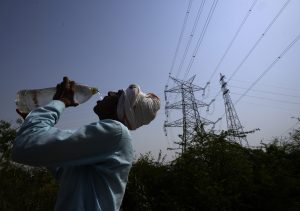Rani, a domestic worker in New Delhi, travels 10-15 kilometers every day from her cramped urban slum in Goyla Dairy, Najafgarh, to high rise buildings in Dwarka. Sometimes she hops on a shared rickshaw, or hangs by the door of an overloaded minibus. Traveling is just one of the difficult parts of her day when she is forced to endure the heat. Generally, “the entire days are exhausting,” she said on a sweltering early May evening, sitting on a cot outside her one-room apartment.
As she narrated the horror of that day’s morning to her four children and me, her dupatta continuously switched jobs. Sometimes the shawl was a fan in her hand and sometimes it acted as a tissue wiping sweat from her face and neck.
While going to work that day, Rani fell asleep by mistake in the shared rickshaw. “I lost control and almost fell off of it,” she said, bumping her head with her hand as if it was her fault that she could not sleep the previous night.
“It was so hot at night. So many mosquitoes. And no electricity from 9 pm to 5 am” she complained. She and her school-age kids slept for barely an hour, the only time when electricity brought some respite from the unbearable heat. The power cuts have become quite frequent this year, according to Rani.
Her family is not alone.
Heat arrived in India well before summer in 2022. Heatwaves blanketed the entire spring season and broke all records since record-keeping began in 1901.
To defeat the heatwaves, power demand increased in India. That in turn created energy shortages and led to the power cuts that plagued Rani and her family. But heatwaves and the power cuts not only affected households like Rani’s but also the government’s coal policy. The extreme heat raised questions about the further impacts on the environment of combatting such heat – which, in turn, could lead to still more extreme weather events in the future.
While India plans to reach carbon neutral status by 2070, extreme weather events like the recent heatwaves keep pushing India’s energy sector to depend on traditional coal in the absence of enough renewable energy. Government policies were supposed to promote renewables to reduce carbon-intensive power sources, but against the backdrop of extreme heatwaves, coal seemed to be the only option to quickly bring relief amid increasing energy demands.
While there are huge investments coming in the renewable sector, and the government should accelerate the pace of deploying renewables, energy experts also warn that deploying renewables will have huge costs if not done prudently.

































